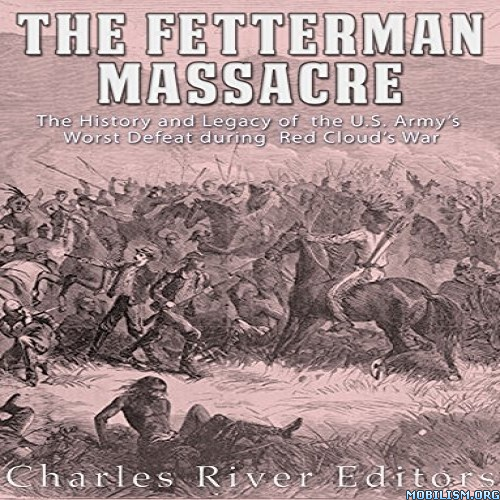The Fetterman Massacre: The History and Legacy of the U.S. Army’s Worst Defeat during Red Cloud’s War by Charles River Editors
Requirements: .M4A/.M4B reader, 45MB
Overview: In the summer of 1866, Colonel Henry B. Carrington set out from Fort Laramie to establish a series of forts along the Bozeman Trail with the goal of protecting migrants moving along the trail. The Bozeman Trail ran through the Powder River country, which included the traditional hunting grounds of Lakota, Cheyenne, and Arapaho peoples. Carrington had about 1,000 people in his column, of which about 700 were soldiers and 300 were civilians, likely soldiers’ families and migrants.
The colonel established Fort Phil Kearny as his headquarters and based 400 troops and most of the civilians there. During the construction of Fort Kearny, which lasted months, Native Americans killed several dozen soldiers and civilians in some 50 separate attacks. The attacks were largely focused on the “wood trains”, comprised of soldiers and civilians harvesting lumber from the surrounding forest for the construction of the fort. Though younger warriors like Crazy Horse conducted the actual attack, Red Cloud and other, older leaders would help plan and direct the harassment and interdiction campaign against the construction of Fort Kearney.
By October 1866, Carrington’s officers and men pressured him to go on the offensive and take the fight to the Native Americans. The pressure was increased by the arrival of a company of sixty-three cavalry troopers led by Lieutenant Horatio S. Bingham in early November. Civil War veterans Captain William J. Fetterman and Captain James W. Powell accompanied the cavalry troopers and were assigned to Fort Kearny as infantry officers, but despite having a distinguished war record, Fetterman had no experience fighting Native Americans. Nevertheless, that lack of experience did not keep Fetterman from criticizing the conservative and defensive posture Carrington had established at Fort Kearny, adding to an already growing chorus of criticism. Fetterman also repeatedly displayed utter contempt for the Native Americans.
Genre: Audiobooks > Non-Fiction > History
On December 19, another wood train was attacked, and Carrington dispatched a mixed company of cavalry and mounted infantry led by Captain Powell. This time, the cautious officer followed Carrington explicit orders not to pursue the Native Americans over the ridge and out of sight of the fort. Powell was successful and returned to the fort unscathed. Carrington continued to emphasize the need for caution until reinforcements and horse arrived from Fort Laramie. Two days later, Native Americans again attacked a wood train, and Carrington dispatched a mixed force of about 50 infantrymen and nearly 30 cavalry troopers and Colonel Carrington again chose Captain Powell to lead the relieving force, but Fetterman asserted his seniority to Powell and was thus given command of the soldiers. Again, Carrington ordered the troops not to pursue the warriors over the nearby ridge and out of sight of the fort.
Meanwhile, the Native American warriors had deployed a group of decoying riders, including Crazy Horse, who lured Fetterman’s troops over the ridge and into the waiting ambush. About midday, soldiers at Fort Kearny heard a large volume of gunfire coming from the north, the direction where Fetterman had led his troops. Carrington dispatched 75 troops towards the gunfire and soon afterwards sent another 48. About an hour later, as the troops topped the ridgeline, they saw a group of some 1,000 warriors in the valley below. Warriors approached and taunted the soldiers, but soon they began to disperse and disappear. Captain Ten Eyck, leading the relief force, cautiously moved onto the battlefield and found Fetterman and his men dead, stripped, and mutilated. Until that time, the Fetterman Massacre, as U.S.
Download Instructions:
https://ouo.io/4y3j8W

